This document discusses the advertising industry’s lessons from public reactions to digital campaigns, focusing on the emotional connections and social dynamics that drive engagement. It analyzes case studies like the Kony 2012 campaign to explore factors influencing online participation and the implications of digital social interactions for marketers. The thesis emphasizes the importance of understanding audience behavior in a rapidly evolving digital landscape to enhance the effectiveness of advertising strategies.

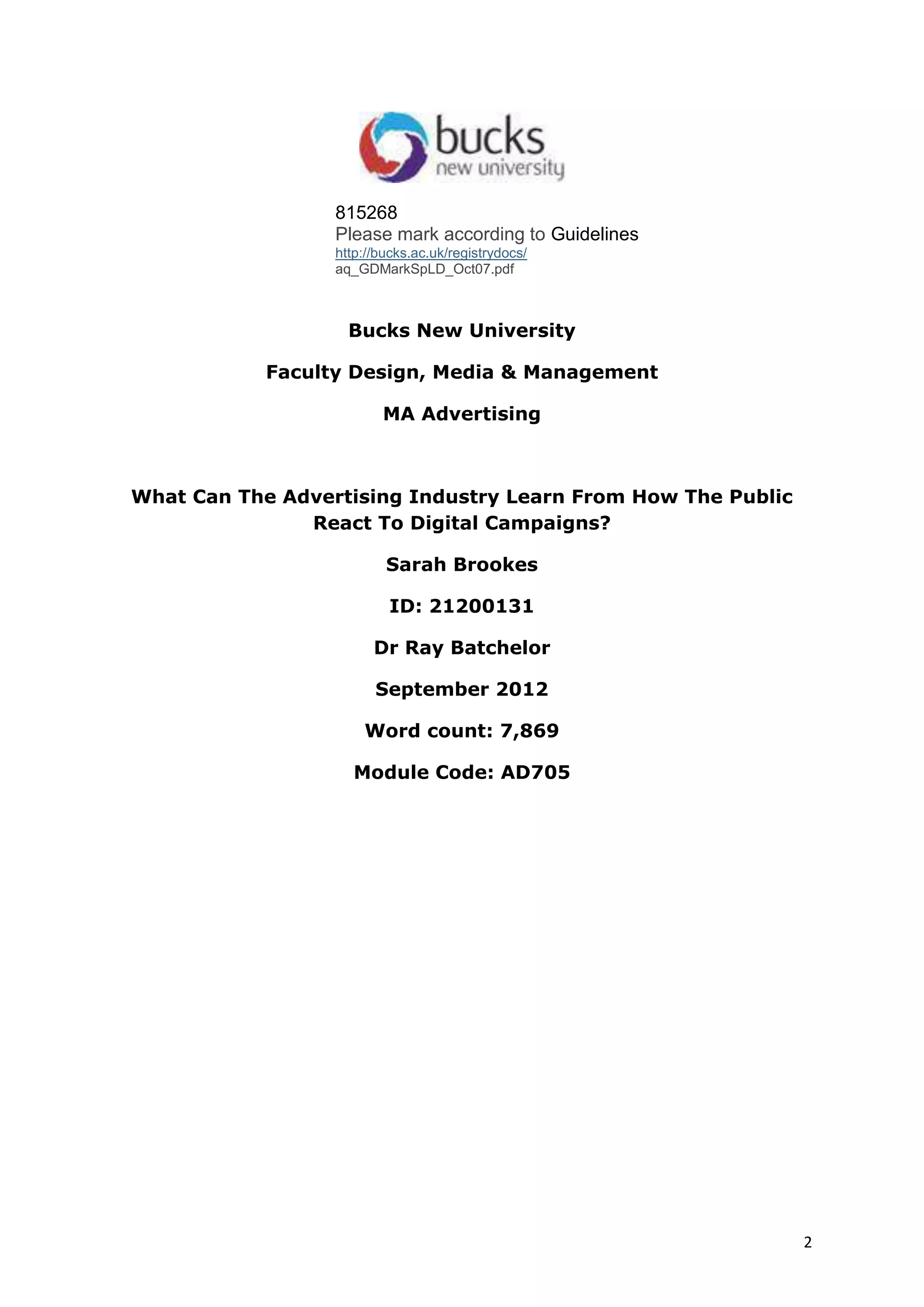
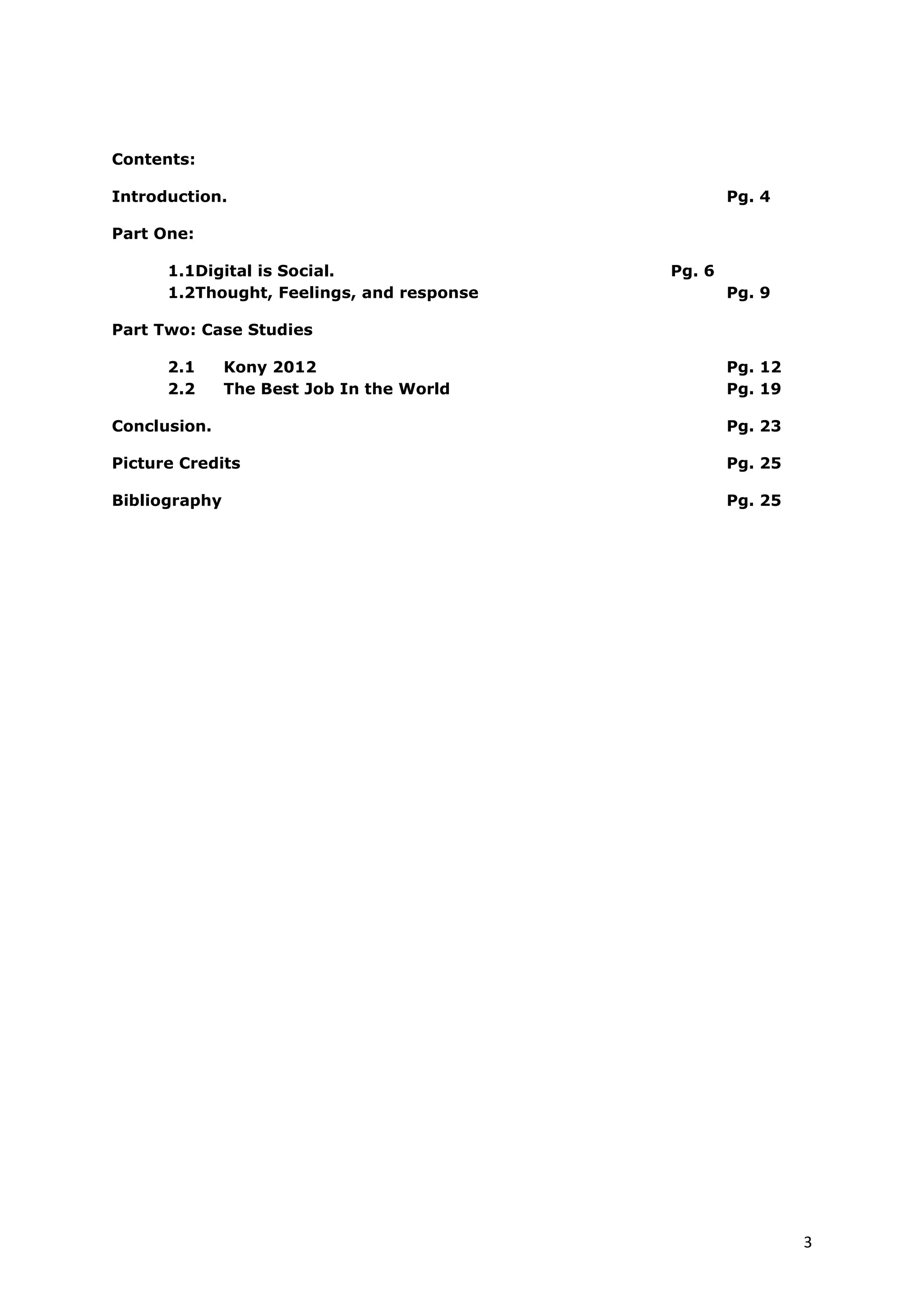

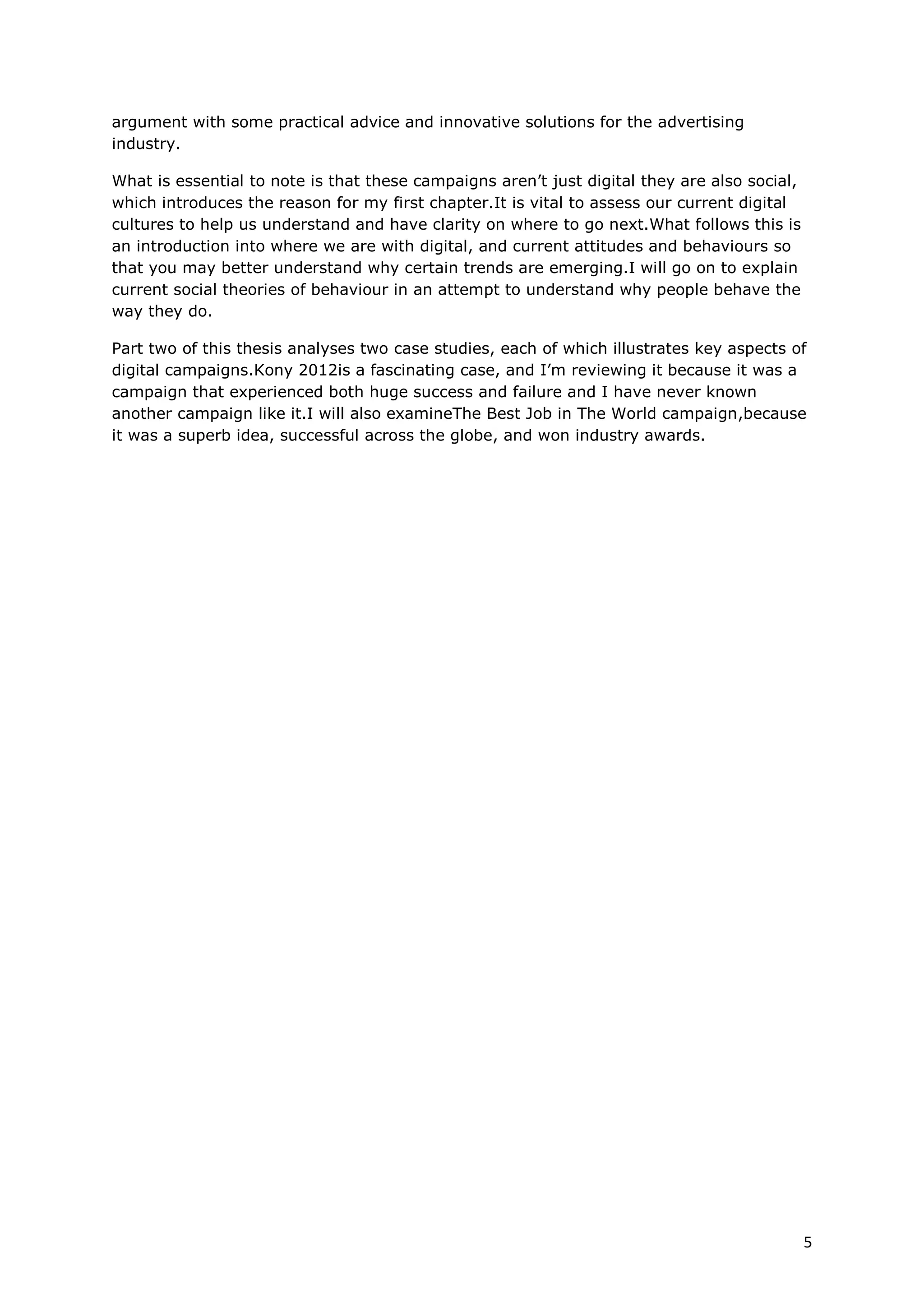



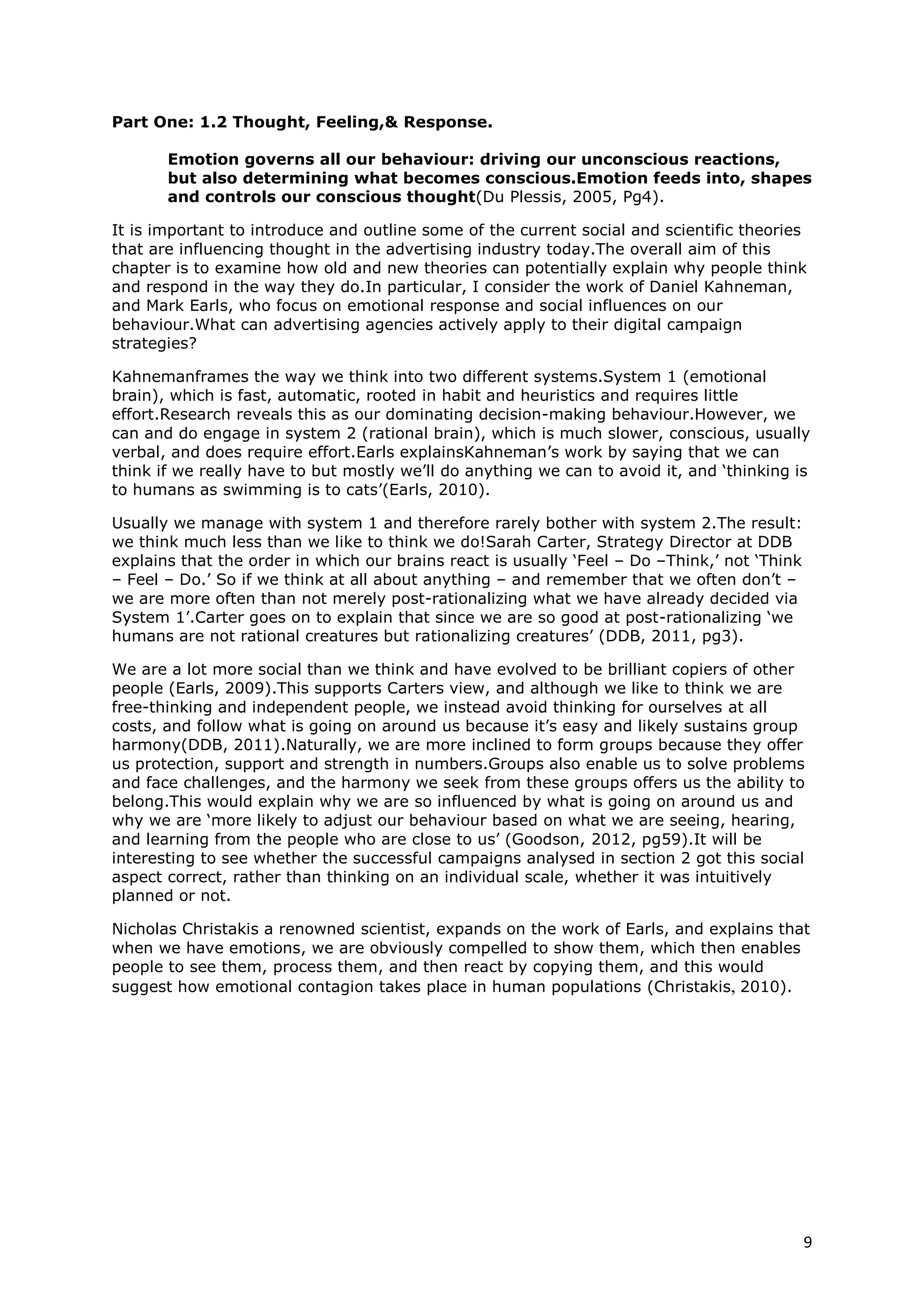







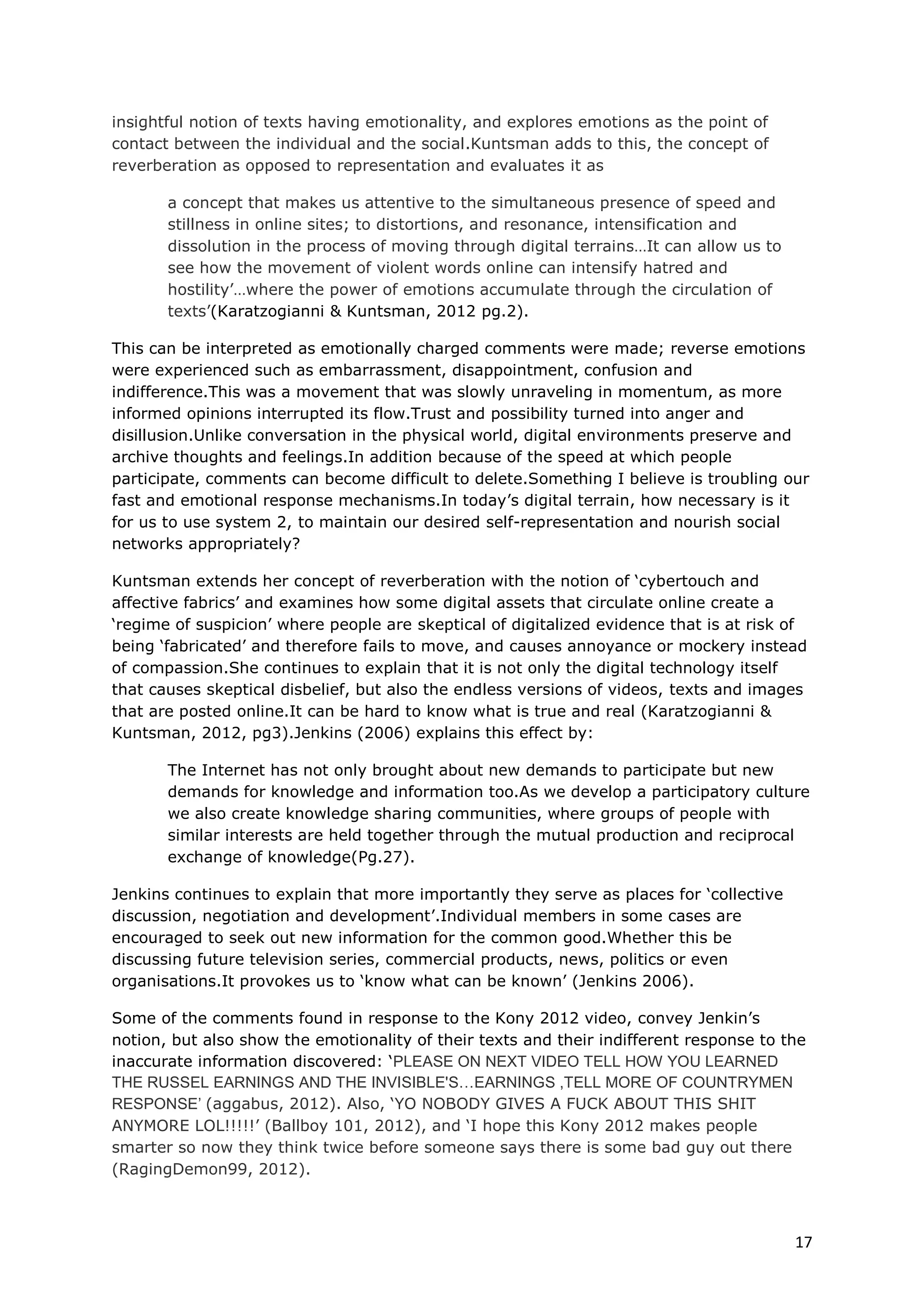
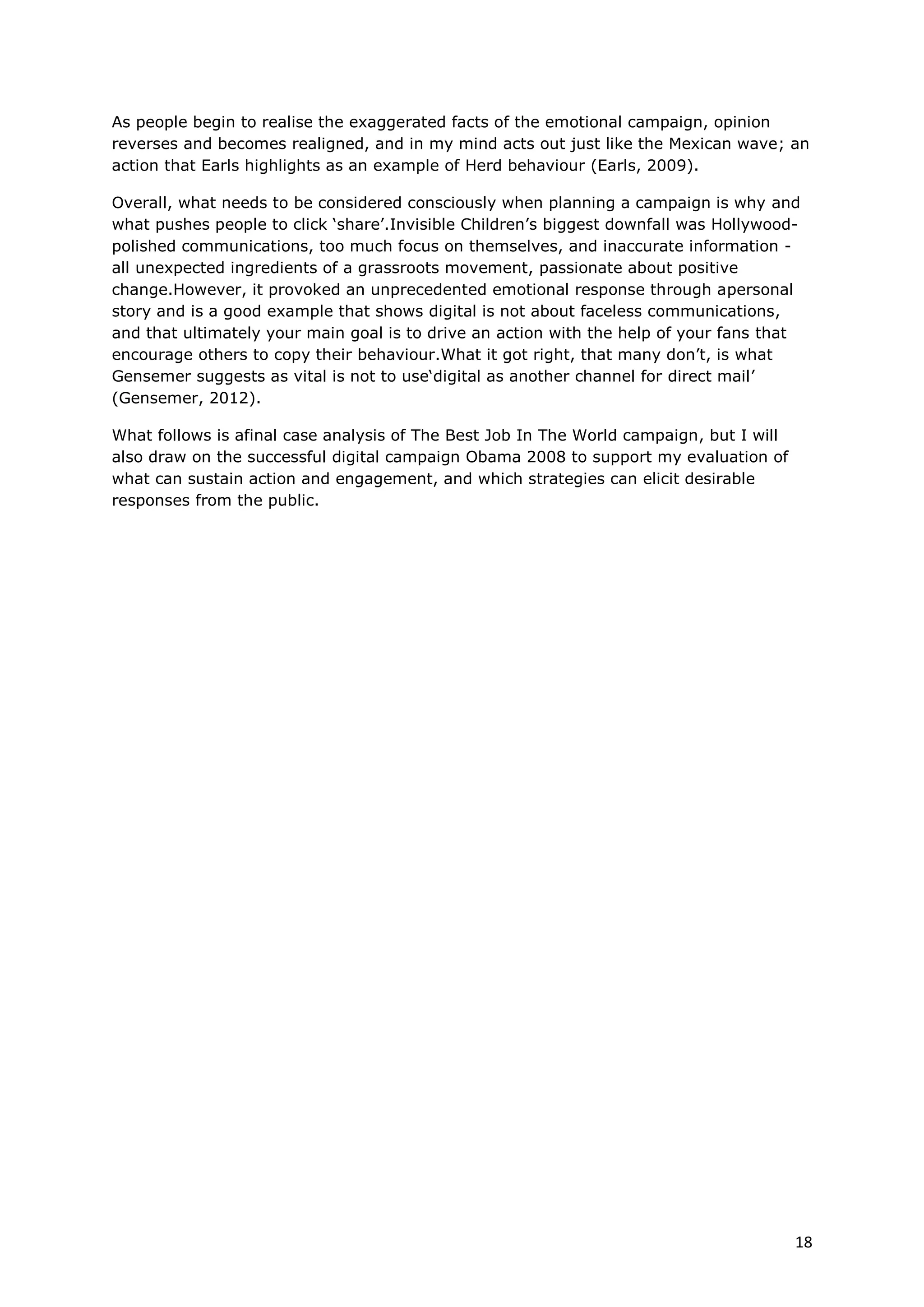

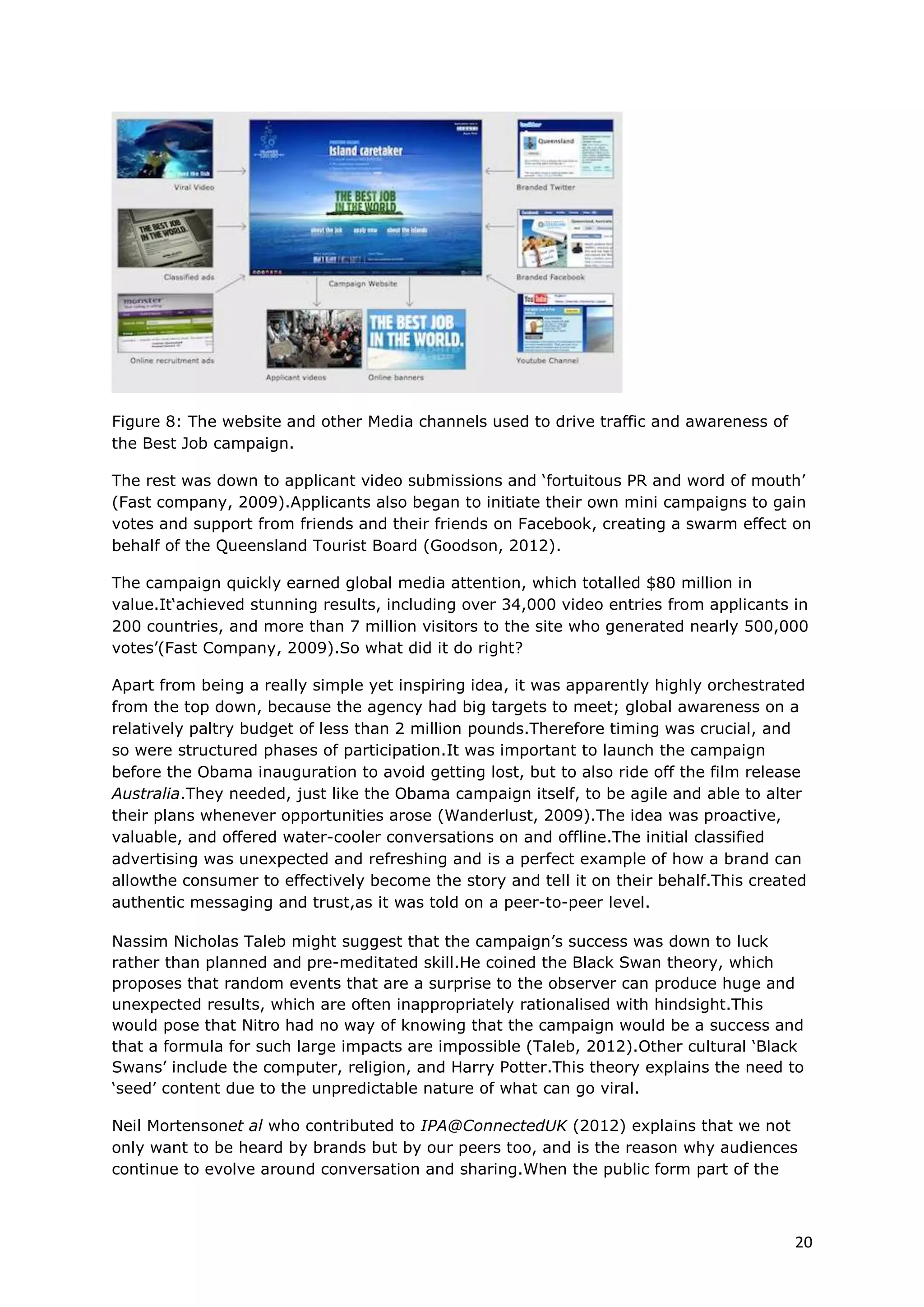


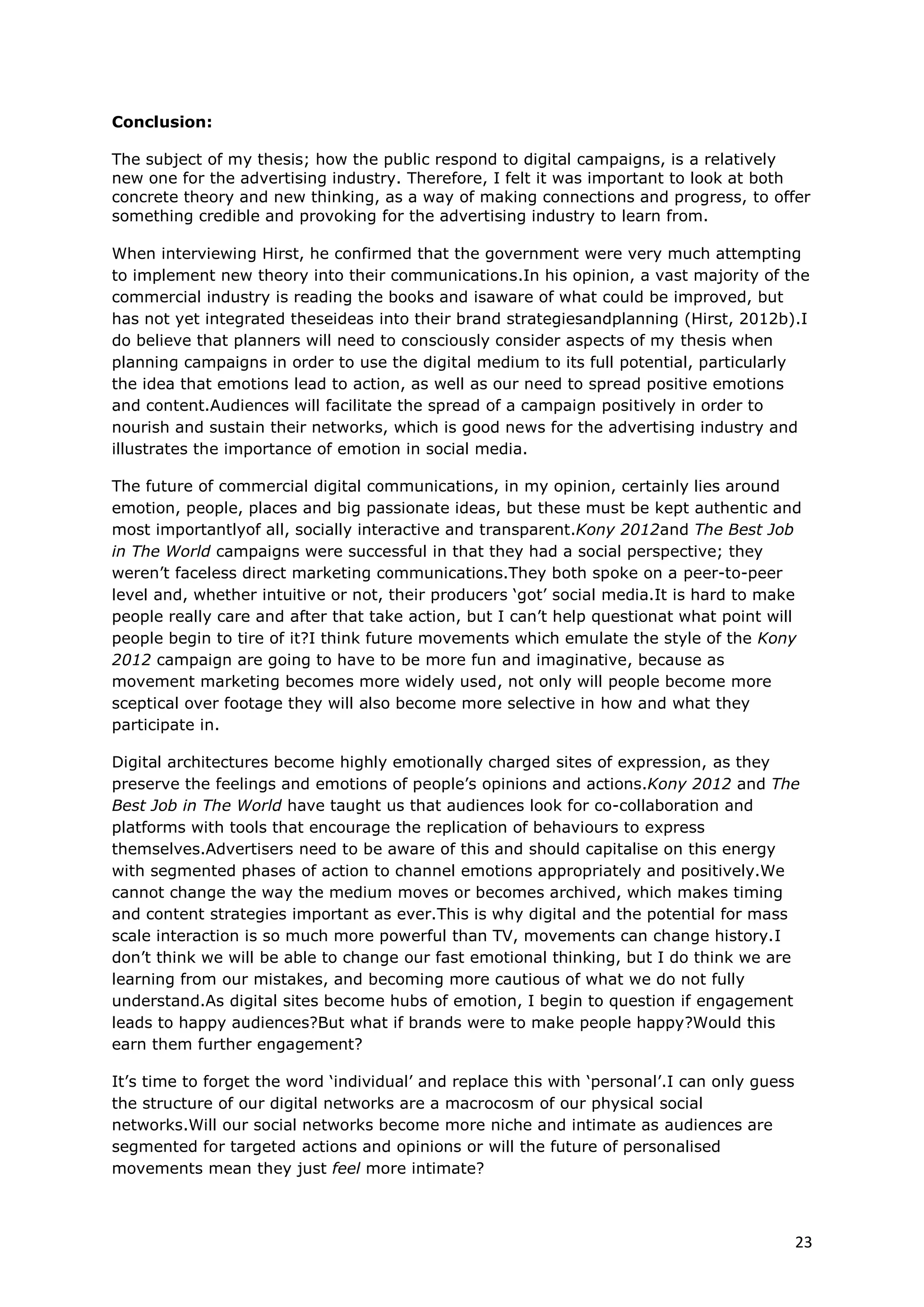
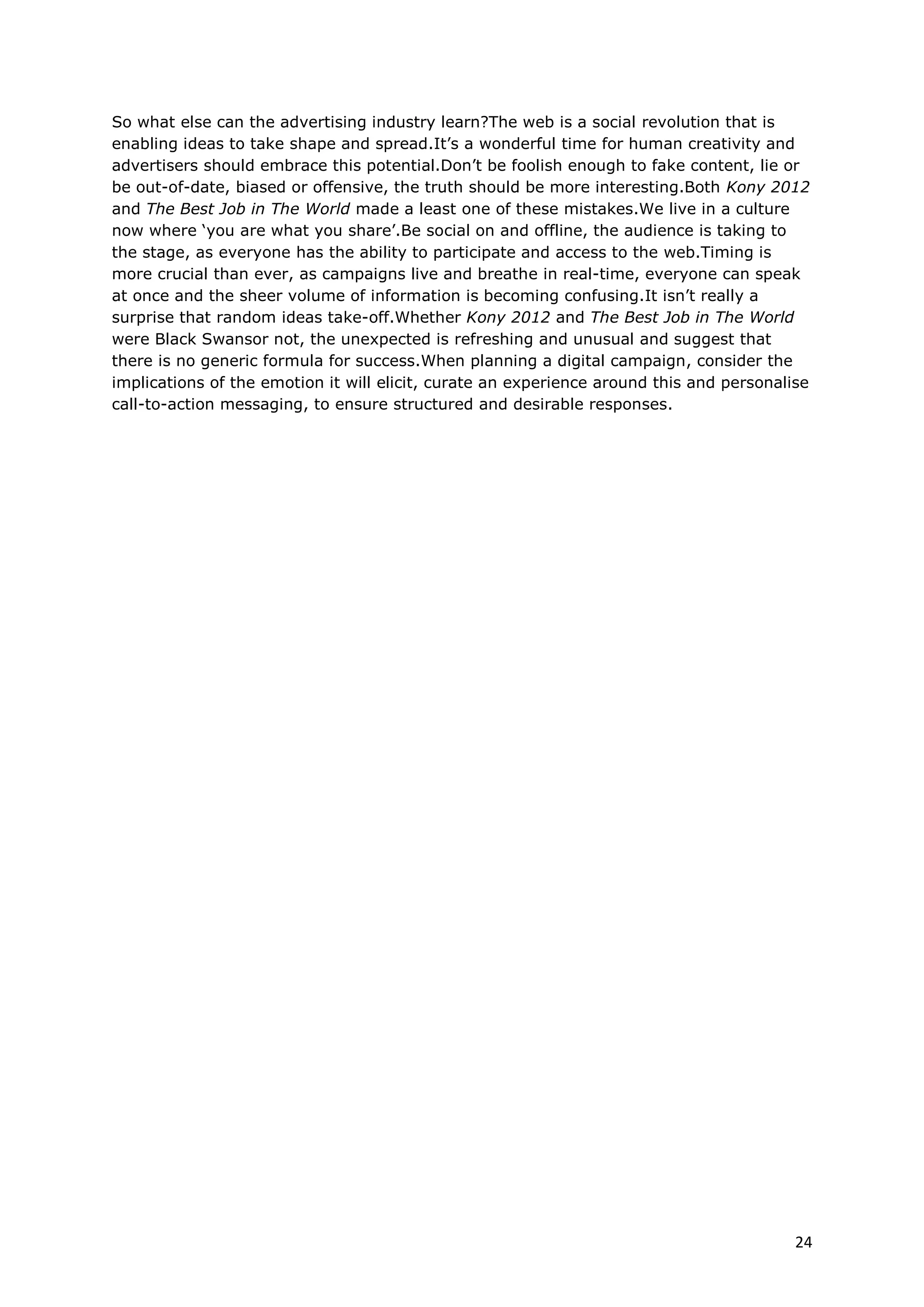
![Picture Credits:
Figure 1:Pg.9Nicholas Christakis, diagram of emotional contagion theory. Screen grab [video online]
Source: http://www.youtube.com/watch?v=2U-tOghblfE
Figure 2: Pg.11 Kony 2012 posters
Source: http://yinnyang.co.uk/2012/03/kony-2012/kony-2012/
Figure 3: Pg. 13 Screen grab of my Twitter feed
Source: https://twitter.com/sarahgenkihai
Figure 4: Pg. 14 Screen grab of the Kony 2012 website
Source: www.kony2012.com
Figure 5: Pg. xx Shows the photos uploaded to the Kony 2012 website for ‘Cover the Night’.
Source: http://ctn.kony2012.com/
Figure 6: Pg.14 Image of Jason Russel’s son who appeared in Kony 2012 video
Source: http://blogs.channel4.com/world-news-blog/kony-2012-inaccuracies-aside-this-is-how-to-spread-
message/20728
Figure 7: Pg. 18 shows the classified newspaper advertisement for Best Job in the World campaign.
Source: http://adsoftheworld.com/media/print/tourism_queensland_best_job_in_the_world?size=_original
Figure 8: Pg. 18 shows the media channels used inBest Job in World campaign
Source: http://www.casestudiesonline.com/bestjob
Figure 9: Pg. 18 Shows screen grab [video online] the replication of the Obama logo across barns in rural states
Source: http://www.youtube.com/watch?v=YZTrcipW8Sk
Bibliography.
Books:
1. Ahmed, S. (2004) The Cultural Politics Of Emotion. USA, Routledge.
2. Airely, D. (2009) Predictably Irrational: The Hidden Forces that Shape Our Decisions. USA, Harper
Collins.
3. Doveling, K. (2012)The Routledge Handbook of Emotions and Mass Media. USA, Taylor & Francis.
4. Du Plessis, E. (2005) The Advertised Mind: Groundbreaking Insights Into How Our Brains Respond To
Advertising. London, Millward Brown.
5. Earls, M. (2009)Herd: How To Change Mass Behaviour By Harnessing Our True Nature. England,
Whiley Ltd.
6. Goodson, S. (2012) Uprising: How To Build A Brand – And Change The World- By Sparking Cultural
Movements. USA, McGraw Hill.
7. Jenkins, H. (2006) Convergence Culture: Where old and new media collide. New York. NYU Press.
8. Kahneman, D. (2011) Thinking Fast and Slow. UK. Penguin Books
9. Karatzogianni, A.& Kuntsman, A. (2012) Digital Cultures and the Politics of Emotion: feelings, affect and
technological change. London, Palgrave Macmillan.
10. Reis, A. & Trout, J. (2001) Positioning: The Battle for your mind. USA, McGraw-Hill.
11. Ryan, D & Jones, C. (2011) The Best Digital Marketing Campaigns in the world. Kogan-Page, UK.
25](https://image.slidesharecdn.com/sarah59thesisfinal-121007113516-phpapp01/75/Sarah-Brookes-MA-Thesis-25-2048.jpg)
![12. Shirky, C. (2009) Here Comes Everybody: How Change Happens When People Come Together.
London: Penguin Books.
13. Springer, P. (2007) Ads to Icons: How Advertising Succeeds in a multimedia Age. London, Kogan-Page.
14. Thaler. R &Sunstein, C. (2008) Nudge: Improving decisions about Health, Wealth and Happiness. USA,
Yale University Press.
15. Williamson, J. (1984) Decoding Advertisements: Ideology and meaning in Advertising. London, Marion
Boyers.
Reports:
1. Carter, S. (2011) Research world versus Real world [online PDF]Available at
<http://www.ddb.com/pdf/yellowpapers/DDB_YP_RsrchWrldvsRealWrld_Feb2011.pdf. >
(Accessed, August 2012)
2. Dare, (2012) Digital Britain [online PDF] Available through
<http://www.thisisdare.com/digitalbritain/> (Accessed, February, 2012)
3. Hirst, N. (2012a)Experience the Future [online PDF] Admap. Available
throughhttp://www.warc.com/Security/LogIn/Default.aspx?> (Accessed, June 2012)
Websites:
1. Age, The. 2009. Best Campaign in The World? [online] Available
at<http://www.theage.com.au/travel/travel-news/best-campaign-in-the-world-20090506-aumm.html>
(Accessed, August 2012)
2. AT&T, 2008. Key Differences between Web 1.0 and Web 2.0 [online] Available at
<http://www2.research.att.com/~bala/papers/web1v2.pdf> (Accessed September 2012)
3. Blue State Digital, 2011. It Gets Better Project [online] Available at
<http://www.bluestatedigital.com/work/case-studies/it-gets-better-project/> (Accessed July 2012)
4. Christakis, N. 2010. The Hidden Influence of Social networks [video online] Available
at<http://www.youtube.com/watch?v=2U-tOghblfE> (Accessed, July 2012)
5. Connected, 2011. The surprising power of social networks and how they shape our lives [online]
Available at <http://connectedthebook.com/> (Accessed, July 2012)
6. CNN, 2012. Kony or Phoney 2012? Exclusive CNN Interview [video online] Available at
<http://www.youtube.com/watch?v=-Ox2TsPZ0a4&feature=related> (Accessed June 2012)
7. Cunniffe, N. 2011. Why emotional advertising doesn’t have to mean ‘consumer benefit’ [online]
Available at <http://room435.wordpress.com/2011/12/22/why-emotional-advertising-doesnt-have-to-
mean-consumer-benefit/#wrapper> (Accessed June 2012)
8. Digital Tends, 2012. Where should you stand on Kony 2012? Just ask your social network [online]
Available at <http://www.digitaltrends.com/opinion/opinion-where-should-you-stand-on-kony-2012-
just-ask-your-social-network/> (Accessed July 2012)
9. Earls, M. 2008. Understanding how behaviour shapes strategy [video online] Available at
<http://www.youtube.com/watch?v=mVFvH8pb0dE&feature=related> (Accessed August 2012)
10. Earls, M. 2010. Mark Earls Says Influencers Don’t Exist [online] Available at
http://thenextweb.com/eu/2010/04/29/mark-earls-the-next-web-conference-keynote/> (Accessed
August, 2012)
11. Emerging Critic, 2012. Kony 2012. Don’t Wag the Dog [online] Available at
http://emergingcritic.wordpress.com/2012/03/09/kony-2012-dont-wag-the-dog/> (Accessed, August
2012)
12. Fast Company, 2009. 6 Lessons From The Best Marketing Campaign Ever [online] Available at
<http://www.fastcompany.com/blog/rohit-bhargava/influential-marketing/7-lessons-best-marketing-
campaign-ever>(Accessed June, 2012)
13. Facebook Live, 2012. How Does Memory Change in the Virtual World? [video online] Available at
http://www.livestream.com/facebookguests/video?clipId=pla_bee5b76b-9c39-4603-af01-
0651fb6184b4> (Accessed August 2012)
14. Gensemer, T. 2012. Campaigning Summit [video online] Available
at<http://www.youtube.com/watch?v=YZTrcipW8Sk> (Accessed May 2012).
26](https://image.slidesharecdn.com/sarah59thesisfinal-121007113516-phpapp01/75/Sarah-Brookes-MA-Thesis-26-2048.jpg)
![15. Goodson, S. 2012. Kony 2012 – a movement to help ‘Invisible Children’ [online] Available at
http://www.uprisingmovements.com/blog/kony-2012-a-movement-to-help-the-invisible-children/>
(Accessed, August 2012)
16. Guardian, The. 2009. Best job in the world storms Cannes Lions advertising awards [online]
Available at <http://www.guardian.co.uk/media/2009/jun/23/best-job-advertising-awards> (accessed
June, 2012)
17. Guardian, The 2012. Kony 2012: What’s the real story? [online] Available at
http://www.guardian.co.uk/politics/reality-check-with-polly-curtis/2012/mar/08/kony-2012-what-s-the-
story> (Accessed, July 2012)
18. Huntingdon, R. 2012. Does oxytocin hold the answer? [online] Available at
http://www.adliterate.com/2012/08/does-oxytocin-hold-the-answer/> (Accessed, August 2012)
19. Infovision, 2012. IPA@ConnectedUK: Something To Talk About [online] Available at
<http://infovisionipa.blogspot.co.uk/2012/05/ipaconnecteduk-something-to-talk-about.html>
(Accessed June 2012)
20. Jezebel, 2012. Think Twice before donating to Kony 2012, the charitable meme du jour [online]
Available at http://jezebel.com/5891269/think-twice-before-donating-to-kony-2012-the-meme-du-
jour> (Accessed, August 2012)
21. Knickerbocker, n.d. Prosocial Behaviour [online] Available at
http://learningtogive.org/papers/paper52.html> (Accessed, August 2012)
22. Leadbeater, C. 2008. We Think [video online] Available at
<http://www.youtube.com/watch?v=qiP79vYsfbo>(Accessed, August 2012)
23. Mollahasani, M. 2012. The ups and downs of Kony 2012 [online] Available
at<http://uprisingmovements.com/blog/the-ups--downs-of-kony-2012/> (Accessed, August, 2012)
24. PR Next, 2009. Case Study ‘Best Job in the World campaign winner of the inaugural PR award at
Cannes 2009 [online] Available at <http://prnext.wordpress.com/2009/07/20/case-study-best-job-in-
the-world-campaign-winner-of-the-inaugural-pr-award-at-cannes-2009/> (Accessed, August 2012)
25. Social Fresh, 2012. Why People Share Things online: Dopamine [online] Available at
<http://socialfresh.com/we-share-online-because-of-dopamine/>(Accessed June 2012)
26. Spring, 2007. Why Groups and Prejudges form so easily: Social Identity Theory [online] Available at
<http://www.spring.org.uk/2007/11/why-groups-and-prejudices-form-so.php> (Accessed August
2012)
27. Taleb, N. 2008. What is a Black Swan? [video online] Available
athttp://www.youtube.com/watch?v=BDbuJtAiABA> (Accessed, August 2012)
28. Telegraph, 2012. ‘Best Job In The World’ took it’s toll on tired Briton [online] Available at
<http://www.telegraph.co.uk/news/worldnews/australiaandthepacific/6924614/Best-job-in-the-world-
took-its-toll-on-tired-Briton.html> (Accessed June 2012)
29. Thaler, R. 2011. Nudge: An Interview [video online] Available at
<http://www.youtube.com/watch?v=xoA8N6nJMRs> (Accessed, August 2012)
30. Tourism Queensland, 2009. Best Job In The World (case) [video online] Available at
<http://www.youtube.com/watch?v=SI-rsong4xs> (Accessed June 2012)
31. Wilderdom, 2003. Role of Schemas in Personality [online] Available at
http://wilderdom.com/personality/L11-1RoleOfSchemasInPersonality.html (Accessed, August 2012).
32. Wunderlust, 2009. Social media practices in destination marketing [online] Available at
<http://www.createwanderlust.com/best-practices-for-social-media> (Accessed June 2012)
33. W3, 1999. Weaving The Web [online] Available at http://www.w3.org/People/Berners-
Lee/Weaving/Overview.html> (Accessed, August 2012)
34. Zak, Dr P. 2012. Is Morality a Chemical? [online] Available at <http://www.moralmolecule.com/>
(Accessed, August 2012)
Social Networks:
aggabus, (2012) Kony 2012. YouTube [online] Available from http://www.youtube.com/> (Accessed August
2012).
27](https://image.slidesharecdn.com/sarah59thesisfinal-121007113516-phpapp01/75/Sarah-Brookes-MA-Thesis-27-2048.jpg)
![Ballboy 101, (2012) Kony 2012. YouTube [online] Available from http://www.youtube.com/> (Accessed August
2012).
RagingDemon99, (2012) Kony 2012 YouTube [online] Available from<http://www.youtube.com/> (Accessed
August 2012).
Personal Communication:
th
1. Dr Paul Springer, Head of Research at Bucks New University, [conversation] ‘Thesis ideas’ 4 May,
2012.
2. Brookes,S. sarah.brookes@yahoo.com (2012) MA Creative Planning thesis chat [Email] message to
th
Cunniffe, N. Neasa.cunniffe@gmail.com received Tuesday June 10 2012 at 4.42pm Accessed June 10
2012.
th
3. Nick Hirst, Associate Planning Director, Dare, [Interview] ‘Emotion in the digital space’ 19 June 2012b.
4. Dusan Hamlin (joint CEO), M&C Saatchi, [Agency visit] March, 2012.
th
5. Mark Earls, author and strategy consultant, [Twitter] August 8 2012 Available
at:https://twitter.com/sarahgenkihai
28](https://image.slidesharecdn.com/sarah59thesisfinal-121007113516-phpapp01/75/Sarah-Brookes-MA-Thesis-28-2048.jpg)